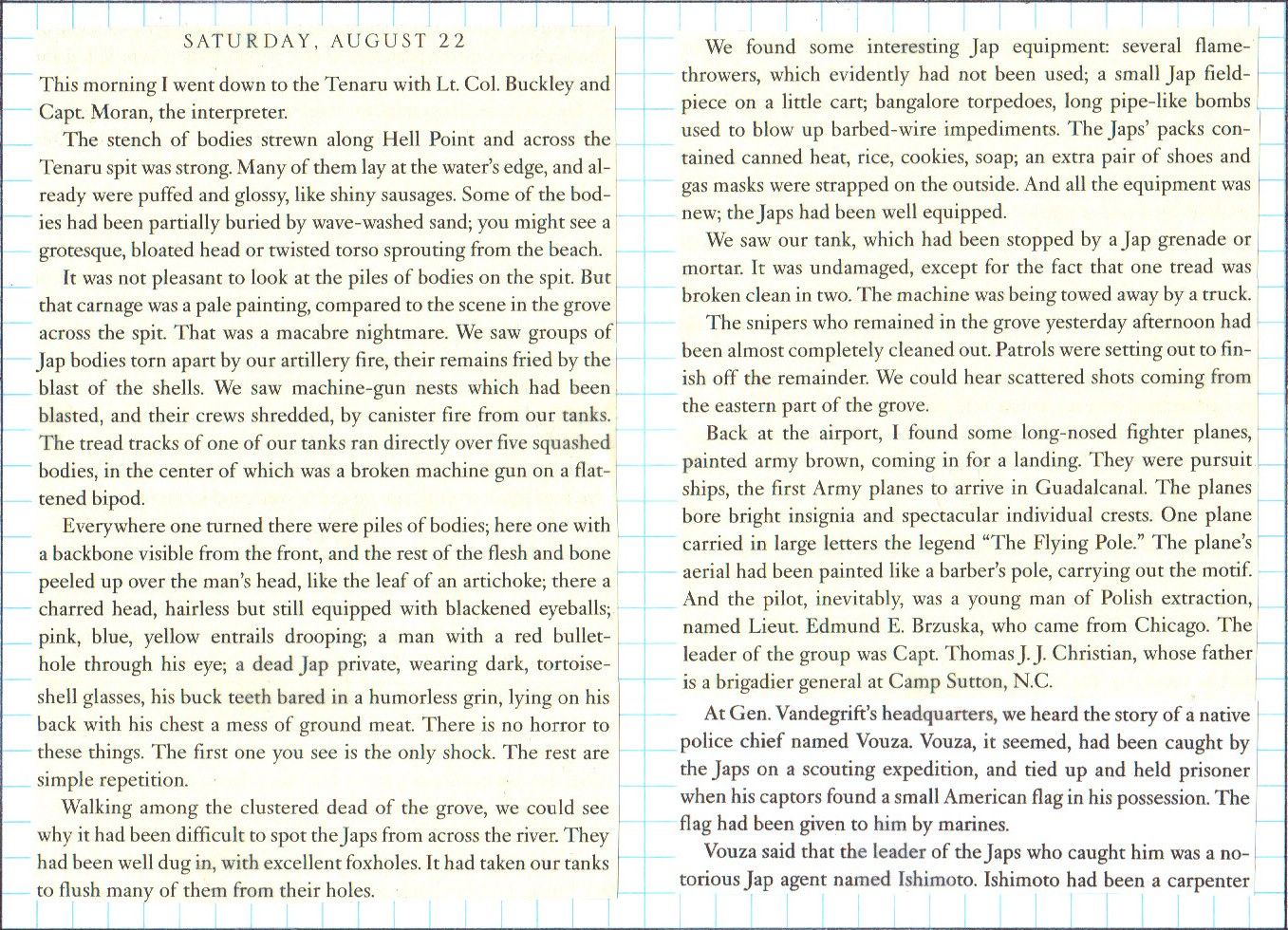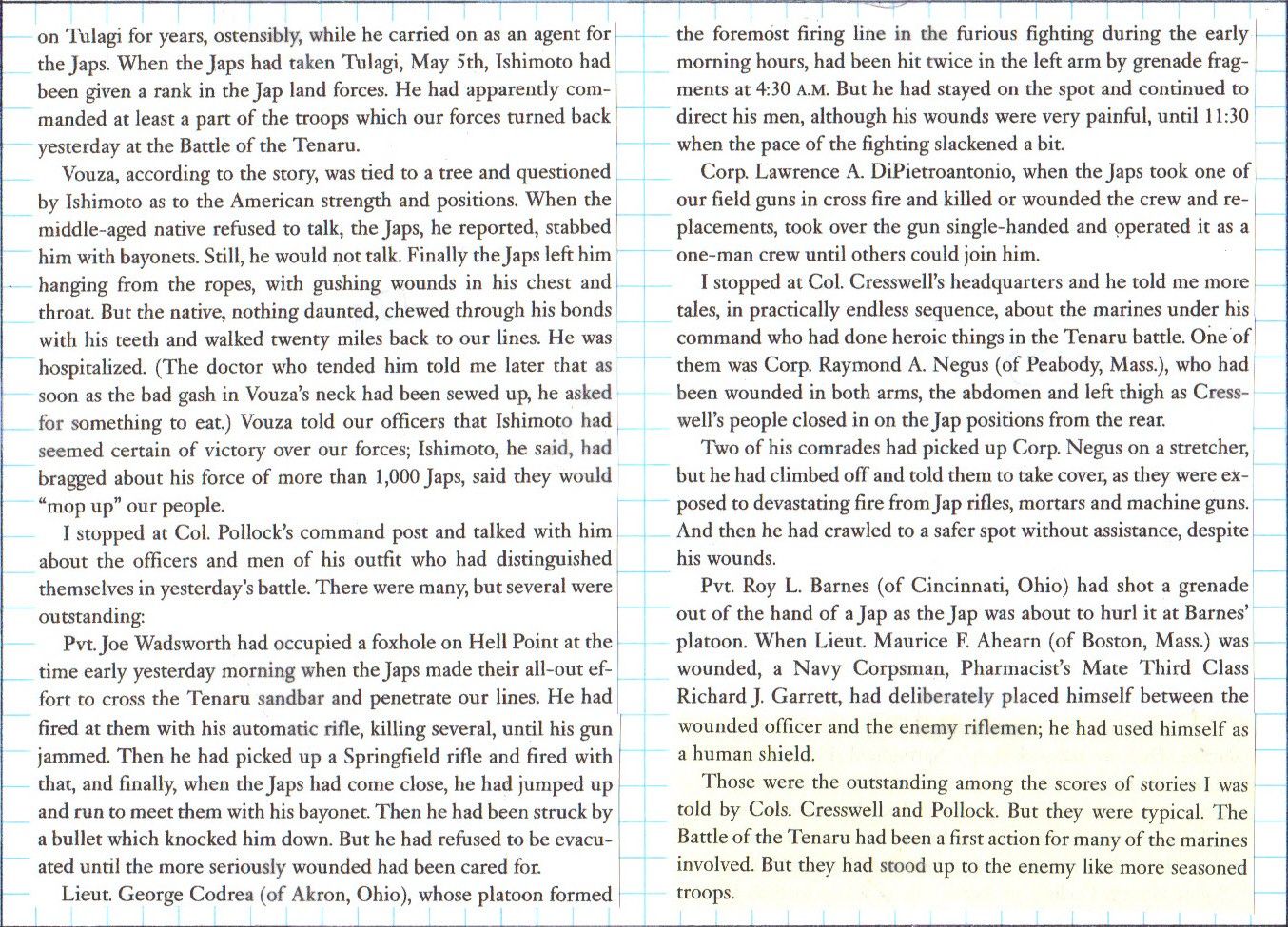

Richard Tregaskis, Guadalcanal Diary
A follow-up on the front page story about the young American, Donald Joseph CURTIN, from the Bronx who secretly went to Canada to join the RCAF in 1941 (lied to his mother about job at shoe company) and received the Distinguished Flying Cross in August 1942:
http://www.london-gazette.co.uk/issues/35900/supplements/751/page.pdf
Air Ministry, izth February, 1943
ROYAL AIR FORCE.
The KING has been graciously-^pleased to approve
the following awards in recognition of gallantry displayed
in flying operations against the enemy —
Bar to Distinguished Flying Cross
Acting Flight Lieutenant Donald Joseph CURTIN,
DFC (Can/J 9340), Royal Canadian Air Force,
No 106 Squadron
Since the award of the Distinguished Flying
Cross this officer has participated in numerous
operational sorties against heavily defended targets
in the Ruhr and in North Italy During a
daylight raid on Milan in October, when attacked
by two enemy fighters Flight Lieutenant Curtm
skilfully evaded them and enabled his gunners
to destroy i and drive off the other. On two
consecutive nights in January, 1943, he took
part in attacks on Berlin, on the second occasion
spending 30 minutes over the target to ensure
accurate bombing This officer has always
displayed the greatest courage and devotion to
duty.
http://www.warbirdinformationexchange.org/phpBB3/viewtopic.php?p=457066
One of Joe’s neighborhood lifelong friends was fellow civilian pilot, Donald Joseph Curtin. It was Curtin who suggested that they should head North to Canada and join the Royal Canadian Air Force (RCAF). Because of the war, Don had been laid off from his job as a cruise director with the Holland America Steamship Company.
“Within two days”, McCarthy recalled, “Don and I boarded a bus and headed for Ottawa, Ontario. We crossed the St. Lawrence river by ferry and the Canada Customs people helped us get a connecting bus to Ottawa. We spent the night at the YMCA and the following morning, May 5, 1941, we proceeded to RCAF No. 12 Recruiting Centre. There we were told we would have to come back in six weeks. Don and I responded we didn’t have the money to return again so if the Air Force wanted us they had better decide that day!” The Warrant Officer in charge took a second look at the two American volunteers, changed his mind and had them sign enlistment papers. That was fine with both as all they wanted to do was fly.
Later that day, as Aircraftsmen Second Class (AC2) Airmen, they, along with thirteen other new recruits, were on a Westbound train headed to No. 1 Manning Depot (MD) in Toronto, Ontario.
After MD training, they attended No. 1 Initial Training School (ITS) also in Toronto from where they graduated on August 11.
Promoted from AC2 to Leading Aircraftsmen (LAC), McCarthy and Curtin reported to No. 12 Elementary Flying Training School (EFTS) located at Sky Harbour Airport in Goderich, Ontario. There they flew Fleet Finch Biplanes, easily passing out of the course on September 26.
Next the two friends were sent to No. 5 Service Flying Training School (SFTS) in Brantford, Ontario where they learned to fly the twin-engined Avro Anson.
Once, during his training at No. 5, “Big Joe”, low on fuel and hopelessly lost, landed in a farmer’s field to ask directions after his navigation map flew out the open window of the cockpit. That slight blemish on his training record did not preclude him from winning his Wings.
McCarthy and Curtin graduated near the top of their class on December 18, 1941 as Sergeant Pilots (SP’s) and, within hours, both were commissioned from the ranks as Pilot Officers (PO’s).
Their Officer Service Numbers were only six digits apart - Curtin’s was J.9340 and McCarthy’s was J.9346. Taking their two week pre-embarkation leave, they returned to the New York area where they spent time with their families over the Christmas/New Year holidays.
Don Curtin headed overseas before Joe and, after training at two Operational Training Units (OTU’s), went on to fly Avro Manchesters and Lancasters with RAF No. 106 Squadron from Syerston in Nottinghamshire. PO Curtin was awarded a British Distinguished Flying Cross (DFC) on his first sortie in July, 1942 and a further award of a Bar to his DFC was approved in January, 1943. During the eight month period Curtin flew with No. 106, his Commanding Officer, was twenty-three year old WC Guy P. Gibson.
WWII Canadian War Dead, February 25, 1943:
http://www.canadaatwar.ca/memorial/world-war-ii/date/1/19430225/
Donald Joseph Curtin Royal Canadian Air Force Flight Lieutenant February 25, 1943